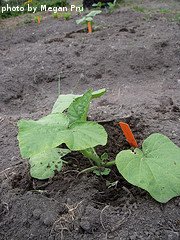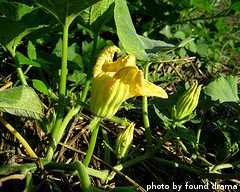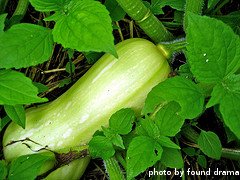Watering and Fertilizing Butternut Squash
You can begin fertilizing butternut squash before you even sow the seeds. As they grow, the plants do well with additional fertilizer applications. It's important to begin watering butternut squash plants when the seedlings emerge, if you don't get any rain in your area. These steps will help your plants to produce lots of high quality squash later in the growing season.
Watering Butternut Squash Plants
You want your squash plants to get large enough to produce and support several nice size squash. They can't accomplish this feat without adequate water.
Butternut squash plants need about an inch of rain per week for best results. If you don't get any rain in your area for 7-10 days, you'll need to provide the water yourself.

A long, slow soak is best when watering squash plants. You want the water to slowly permeate the soil and eventually reach the root system. Your butternut squash plant will then absorb the water from the soil, along with all the nutrients it can get. This energy is stored up until fruit production begins. Avoid using high water pressure as it may erode away the soil that covers the roots. Concentrate the water at the base of the plant. Try not to water the tops of the plants as this may encourage disease and pest problems. Wet leaves are a breeding ground for fungal infections. It's best to water in the early morning hours. This way, any excess water will be evaporated by the afternoon sun.
To determine if your plants need watering, use your fingers and dig down a few inches into the soil next to your squash plants. If the dirt is moist at this depth, you're probably in fine shape. If the dirt is dry, it's probably time to water. The best to determine this is to grab a handful of dirt and squeeze it in your palm. You want it to be moist enough to hold together for a few seconds before falling apart. If it just sticks together and doesn't fall apart, you probably don't need to water. Wait a couple of days and check again. If the dirt crumbles easily in your palm, the plants are likely thirsty.
To keep the soil moist, a layer of mulch can be applied around your butternut squash plants. Grass clippings, chopped up leaves or straw work well as mulch. These organic materials can be tilled under at the end of the growing season, adding nutrients to the soil for next year.
Fertilizing Butternut Squash Plants
Butternut squash plants feed heavily to produce lots of high quality squash. Fertilizer can be applied to the plants to give them the nutrients they need. You can use a granule type fertilizer or a water soluble type, whichever is easiest for you.

The first time for fertilizing butternut squash plants is when the seedlings are a few inches tall. A dose of fertilizer at this stage will help the plant to get as large as possible. Larger plants mean bigger, more well formed squash. Once the plants begin to take off and get big, avoid adding more fertilizer until after the blossoms appear. This will encourage the plant to focus its energy on producing squash. After the blossoms appear, another dose of fertilizer can be applied to maximize fruit production.
When using a granular type, choose a well balanced one such as 10-10-10 or 12-12-12. These numbers indicate the percentages of nitrogen, potassium and phosphate in the fertilizer mixture. Equal percentages of these 3 key ingredients will help the plant to grow large and produce high quality squash. Just scatter the granules on the ground around the plant and water them in well. Try not to let the granules touch the plants as it may cause them to burn. Apply the granules at the rate recommended by the manufacturer - usually 1 1/2 pounds per 100 square feet.
If you use a water soluble fertilizer, mix it according to the manufacturer's directions. Apply it when you would normally water your plants. Again, a balanced, all-purpose fertilizer will work nicely.
We apply a balanced granular fertilizer to our squash patch about a week before we plant. We water it in well and then till one last time before planting. After that, we switch to a water-soluble fertilizer product and apply it when we water our plants.
Now that you've learned about watering and fertilizing butternut squash plants, the next step is to harvest your crop.

Click here to learn about harvesting butternut squash
Click here for some of our favorite butternut squash recipes
Click here for help diagnosing and curing common butternut squash plant problems
Click here to move from our Watering and Fertilizing Butternut Squash page to our Growing Butternut Squash main page
Click here to return to our Home page